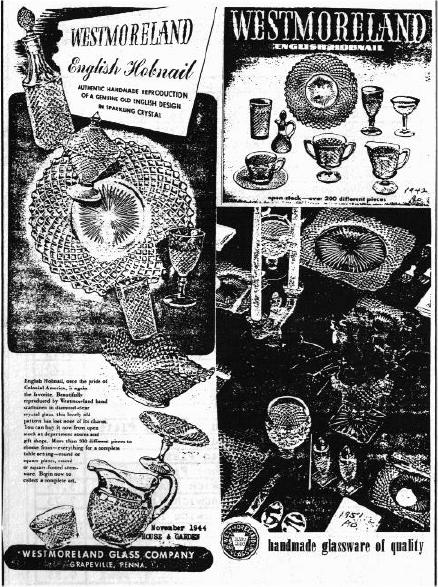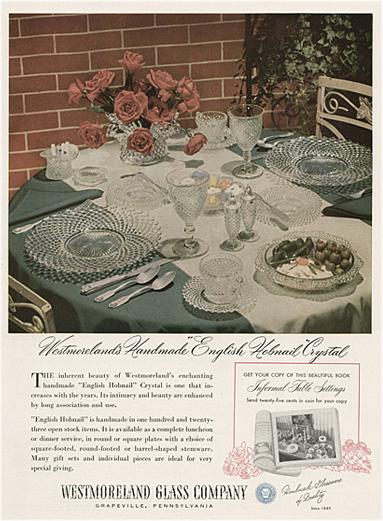National Depression Glass Association
Preserving America's Glass Manufacturing Heritage
English Hobnail
by Virginia Scott
Rainbow Review Glass Journal - October 1974
Westmoreland Glass Company of Grapeville, PA, named "English Hobnail" their most popular pattern for Elizabeth Gordon's 1942 Survey "The 15 Most Popular Glassware Patterns." (House Beautiful, Dec. 1942).
Westmoreland began operations in 1889, two years after Sandwich Glass Co. closed. The company, which is still in operation, has specialized in producing authentic reproductions of Early American glass. The hand mold process is used and the resulting product is of very high quality.
I have found many ads for Westmoreland's English Hobnail from 1943 to the early 1950s. The 1944 ad shown here states, "English Hobnail, once the pride of Colonial America, is again the favorite. Beautifully reproduced by Westmoreland hand craftsmen in diamond-clear crystal glass, this lovely old pattern has lost none of its charm." Another ad mentions that the pattern is "a century old Sandwich pattern." In her book Early American Pressed Glass, Mrs. Ruth Webb Lee states that "English Hobnail is similar to some early Sandwich salts and that the pattern was made during the 1870s. According to another book by Mrs. Lee, Fakes And Reproductions, The pattern as made by Westmoreland is a more modern form of the original and was originated by Charles West, one of the founders of Westmoreland, about 1893.
English Hobnail has been made in crystal more or less continuously from the earliest issue. From 1928 to 1931, the pattern was made in pink, green and turquoise blue and it was made in amber in 1925-26 and in the 1950s. (Weatherman reference) In the second edition of his book, Gene Florence shows a few pieces in light and dark turquoise, fired-on green, cobalt and amethyst-flashed. Crystal with a black base was made during the early 1930s and pieces have been made in milk glass through the years.
English Hobnail has been made in an extensive line of pieces and shapes and the ads of the 1940s announce that there are "more than 2OO different pieces to choose from" including "everything necessary for complete table service." By 1951, the number of pieces available had been reduced to "one hundred and twenty-three open stock ttems." The pattern was made with round or square plates and round or square-footed stems. Goblets were bell-shaped with a spool-turned stem or barrel-shaped with a hobnail-knobbed stem. Some pieees were hexagonal - notably a flat creamer/sugar set - and tbe footed creamer and sugar have an octagonal base. (See picture, top right) Notice that the rayed center motif is six-sided and that the edges of the piece are blunt rather than pointed.
I was unable to find an ad that gave prices, but most ads stated that the price was "remarkably low." This fact is borne out by the almost unbelievable price given in the 1942 survey for the bell-shaped goblets: $2.50 per dozen. Remarkably low, indeed!
 |
 |